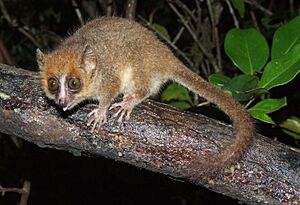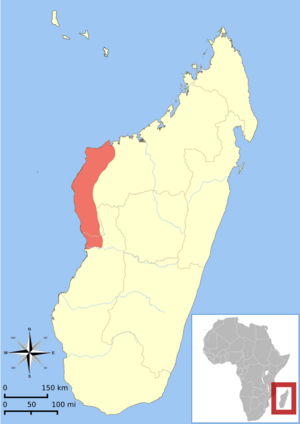Pygmy mouse lemur facts for kids
Quick facts for kids Pygmy mouse lemur |
|
|---|---|
 |
|
| Conservation status | |
| Scientific classification | |
 |
|
| Distribution of M. myoxinus |
The pygmy mouse lemur (Microcebus myoxinus) is a tiny primate from Madagascar. It's also called Peters' mouse lemur or dormouse lemur. This little animal weighs only about 43 to 55 grams, which is like a few strawberries! It's the second smallest of all the mouse lemurs.
Pygmy mouse lemurs have fur that is reddish-brown on their backs. Their bellies are a creamy-white color. They live in dry forests in western Madagascar. You can find them in places like the Tsingy de Bemaraha Nature Reserve. They also live in other areas, including mangrove forests.
It's important to know that information about this lemur can sometimes be confusing. This is because it was once mixed up with another tiny lemur, Microcebus berthae. That lemur is actually the smallest primate in the world! Many older articles might have information about M. berthae but call it M. myoxinus.
Scientists are still learning a lot about the pygmy mouse lemur. We don't know much yet about how they behave or live in the wild. This tiny lemur is only about 12 to 13 centimeters (5 inches) long, not including its tail.
Reproduction and Life Cycle
During the time of year when pygmy mouse lemurs mate, male lemurs travel much farther. Their home range, which is the area they live in, becomes much bigger than the females' areas. Males also tend to gain more weight during this season. This extra weight helps them during the mating period.
Hibernation and Saving Energy
Pygmy mouse lemurs have a special way to save energy during the dry season. They enter a state of inactivity, similar to hibernation. This happens when their body temperature drops below 28 degrees Celsius (82 degrees Fahrenheit).
Female pygmy mouse lemurs are more likely to go into this deep rest than males. This can make the number of males and females seem uneven in some areas. However, in warmer places, it's harder for them to stay in this state for long. In cooler areas, their bodies use about 86% less energy when they are in this inactive state.
Genetics and Species Identity
For a long time, scientists weren't sure if the pygmy mouse lemur was its own species. They thought it might be the same as other mouse lemurs. But recent studies looking at their DNA have shown big differences.
These genetic differences prove that the pygmy mouse lemur is indeed a unique species. Even with these discoveries, scientists still need to study more about the tiny differences in chromosomes among all mouse lemur species.


